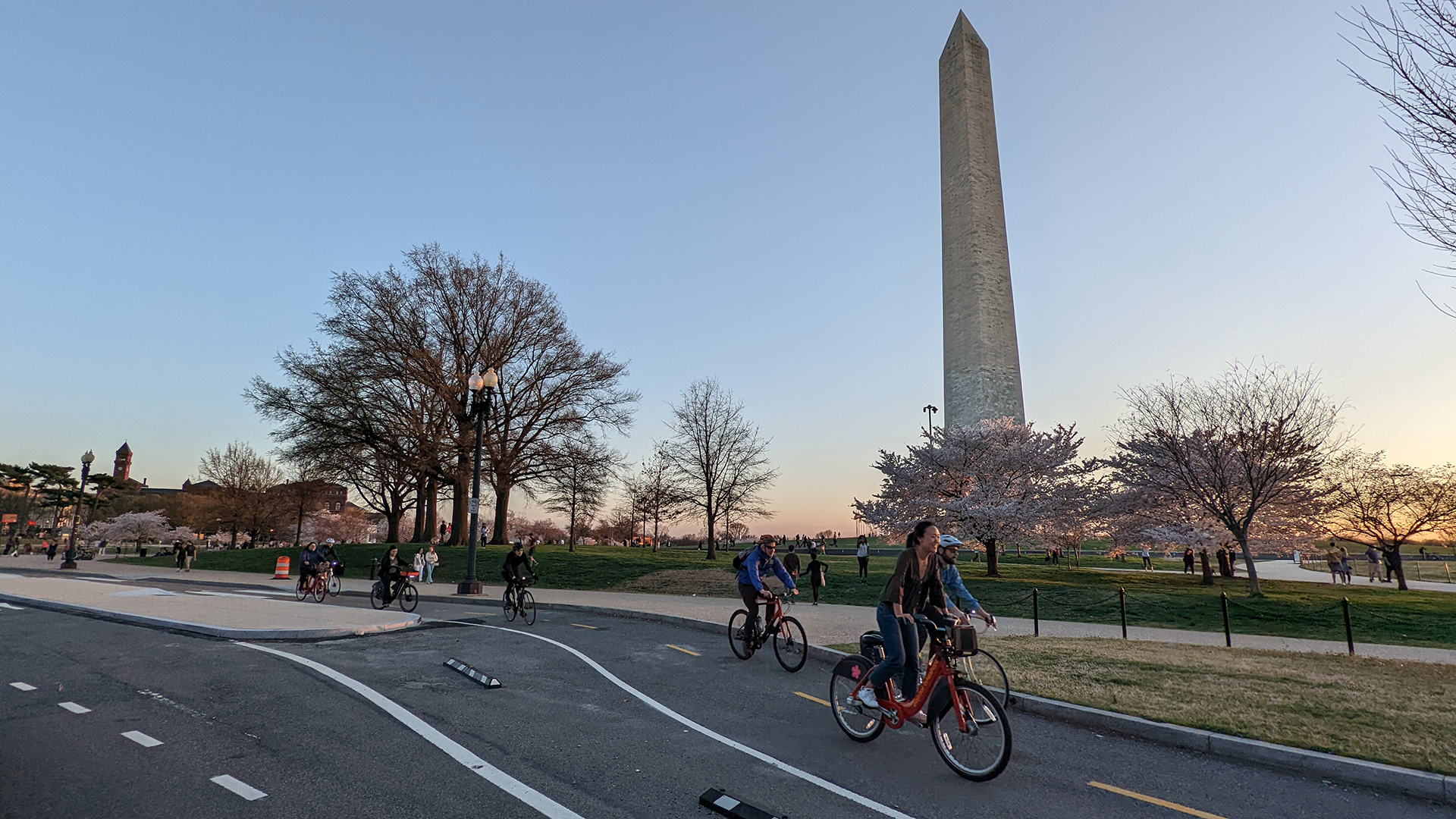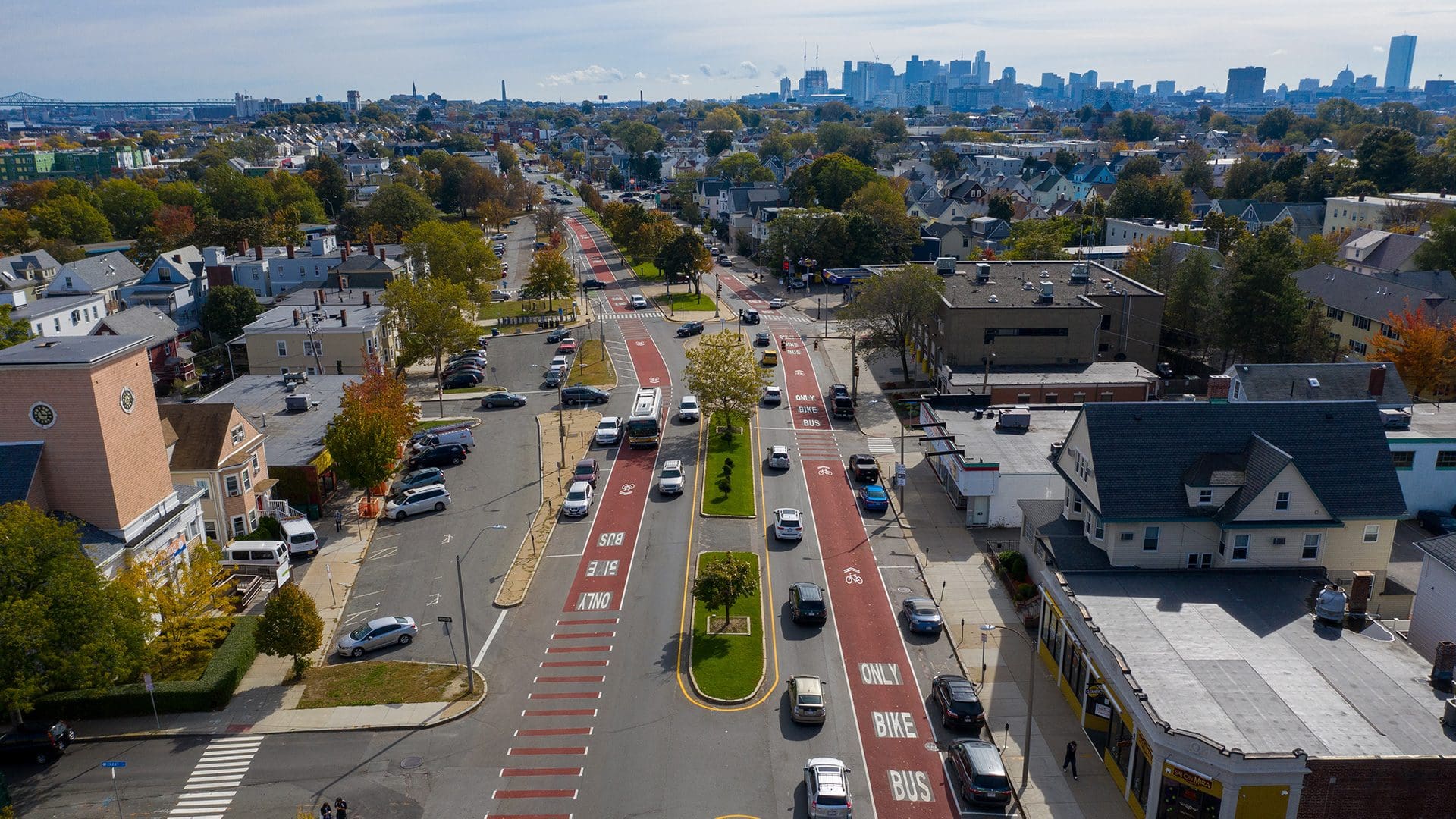May 9, 2022
The power of dedicated bicycle facilities for increasing ridership and improving safety outcomes for bicyclists is well documented. Did you know that bike infrastructure holds a myriad of benefits for other modes of transportation, too?

After bike lanes were added to 15th Street NW, Pennsylvania Avenue NW, and L Street NW in Washington, D.C., sidewalk riding decreased by 70 percent, 52 percent, and 27 percent, respectively, even though more people were biking on those streets overall.
Benefits to Pedestrians
People walking and biking typically travel at very different speeds. When bicyclists don’t have safe places to ride, they are forced to compete either with cars in the travel lane or pedestrians on the sidewalk, both of which open the door for conflicts. Dedicated bike facilities clarify and separate these two modes, giving bike lanes to bicyclists and sidewalks to pedestrians. As reported by the Washington Post, our research showed that after bike lanes were added to 15th Street NW, Pennsylvania Avenue NW, and L Street NW in Washington, D.C., sidewalk riding decreased by 70 percent, 52 percent, and 27 percent, respectively, even though more people were biking on those streets overall.
Protected bike lanes can also offer safety buffers to pedestrians. For example, bike lanes that run along a travel lane provide an additional layer of separation between cars and sidewalks. The presence of bike lanes is also shown to heighten drivers’ awareness of people getting around by active transportation, which makes pedestrians more visible, too.
Benefits to E-Scooter Riders
Safe and available infrastructure is the biggest barrier to increasing micromobility usage across the United States. Expanding facilities for bicyclists also expands facilities for e-scooter riders, who don’t often have safe places to ride. E-scooters can travel at speeds up to 25mph, which is much more comparable to bicycling than walking. And just as with bicyclists, sharing spaces with other modes puts e-scooter riders in conflict, either posing threats to pedestrians or in the vulnerable position of sharing travel lanes with cars.
The Portland Bureau of Transportation (PBOT)’s 2019 E-Scooter Report found that bicycle infrastructure is key to boosting e-scooter ridership, especially in places with high-stress streets. PBOT compared ridership data before and after the construction of bike infrastructure along Portland’s Waterfront Park. They saw a 55% increase in e-scooter ridership on bike paths and a 45% decrease on the park path.
Benefits to Transit Riders
Because bike facilities make the micromobility user experience safer and more comfortable, they can help close the first mile/last mile gap and thus make transit a more attractive option to more people. In other words, bike facilities make it easier to get to and from transit stops. Transit riders can more easily and safely use bike or scooter share (or bring their own bike or scooter) to start or finish their trip on a dedicated bike facility.
In some cases, bicycle facilities can double as transit facilities in the form of a shared bus/bike lane, such as those designed for Broadway in Somerville, MA. These shared facilities are not as high-comfort for bicyclists as separated, dedicated facilities but they enable busses to skip queues and reduce travel time between stops while providing bicyclists with a lane to ride in separate from other vehicles and pedestrians.

In some cases, bicycle facilities can double as transit facilities in the form of a shared bus/bike lane.
Benefits to Drivers
Yes, bike infrastructure benefits drivers, too-in more ways than one!
As noted above, separating bikes and cars in the roadway reduces conflicts between these modes, which makes our streets safer. And we’re not just talking safety for bicyclists. Bike lanes have a traffic calming effect, which is shown to improve safety outcomes for drivers. Adding a bike lane often means reducing the width of the road, which forces drivers to slow down, thus reducing crashes. Of note, improved safety for drivers does not tend to come at the expense of travel time, which sees little to no increase from traffic calming.
Looking at 13 years’ worth of data from 12 cities, researchers at the University of Colorado Denver and the University of New Mexico saw strong correlations between increases in each city’s bicycle mode share and decreases in road fatality rates.
Implementing bike infrastructure can also reduce roadway congestion, as it lures more people out of their cars and into the fresh air and flexibility of getting around on two wheels. Cars take up more space per traveler than any other vehicle on the roadway. Reducing the number of cars on the road improves congestion for those who still do choose to drive.
Benefits to the Community
In addition to these mode-specific benefits, dedicated bicycle facilities bring many large-scale benefits to their communities. A 2021 report from MassTrails sought to quantify the value of active transportation facilities, studying four shared use paths over four months. Their conclusion was that these paths:
- Reduce greenhouse gas emissions and air pollution, translating to approximately $23,000 in cost savings on an average weekday and approximately $3,600 on a weekend day
- Reduce medical costs due to the correlation between walking/and biking and prevention/reduction of chronic illness, estimated to save over $2.8 million dollars on annual health care expenditures
- Improve the local economy, generating between $378,000 and $9.2 million per path for businesses near the trails during the four-month study period, which has a ripple effect into the community, jobs, and tax revenue
This impact on a community’s economy and sustainability benefits everyone who is a part of the community, not just the people who choose to bike.
We’re just scratching the surface on this topic, so if you’d like to discuss any of these ideas in more detail, don’t hesitate to reach out!
